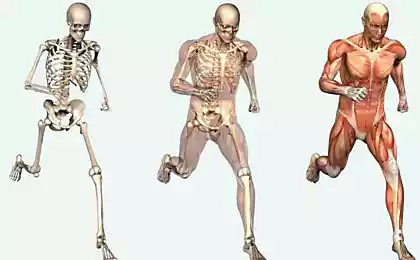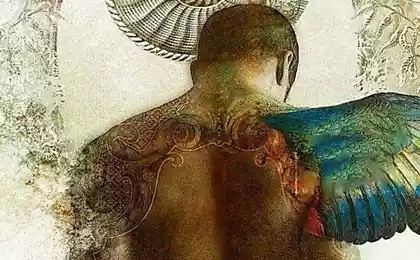797
10 of these errors of nature
Nature does not always create a perfect shape, sometimes it makes mistakes, and these mistakes can look uzhasnoNevazhno what caused the deformity - genetics or environmental factors, they always aroused the curiosity of people around the world. Some owners of ugliness simply accept themselves as they are, and live a full life. Some go for risky operations in the hope of changing their appearance. Some are joining the circus, and use the label "ugly" for earnings. And some just hide away, so that people do not shy away from them in terror.
1. Horn keratoma
Horn keratome (cornu cutaneum) occurs when keratin takes a conical shape and emerges to the outside through the skin in the form of horns. Skin lesions that are found at the base of the horns can be either malignant or benign. Cutaneous horns appear, usually in people with fair skin, aged 50 years or more. And exposed skin are most susceptible to the occurrence of this deviation. To determine the exact reasons for his frequent biopsy, as the horns are often associated with a variety of diseases - from ordinary warts to Bowen's disease. Most horns are benign, but about 20% are able to cause cancer, and another 20% cause a variety of precancerous conditions.
2. Aniridiya
Absolutely black eyes - this is not necessarily a sign of absolute evil. Condition called aniridia can deprive colored iris, which in turn can lead to severe impairment of vision and high light sensitivity.
The literal translation of the word "aniridia" - "without iris". Due aniridia may develop, and other diseases such as glaucoma and cataracts. Anyone who suffers from aniridia, or may be completely blind or can see well enough to drive. This condition causes a genetic mutation. There it around the end of the first trimester of pregnancy, at a time when the fetus develops eye. Aniridia - a hereditary disease. If it was someone from the parents, with a probability of 50%, it can also occur in children.
3. Rekurvatsiya knee sustavov
People with knee rekurvatsiey able to bend your knees back. In the most severe cases, this condition can be caused by congenital dislocation of the knee. In other cases, the cause may be a difference in leg length or a serious disease, such as cerebral palsy or multiple sclerosis. Another reason could be physical trauma of the knee joint. This can happen during sports or during a car accident, for example. In the treatment of this disease can help surgery and physiotherapy. It can also be used for special bracket feet. Depending on whether the treatment would be effective for some patients, this condition can cause permanent disability. Today, the most famous example rekurvatsii knee Harper is Ella (Ella Harper), who lived in the state of Tennessee in 1870. She had to move on all fours. It was called "girl camel».
4. prune belly syndrome
Better known as Eagle-Barrett syndrome, prune belly syndrome causes severe weakness of the abdominal muscles. This leads to the fact that belly droops, wrinkled, and appearance resembles a prune. The bladder of the patient in such a situation, under constant pressure, thus emptying it to the patient can be very difficult. This gives rise to a spectrum of related complications. The causes of this disease to date, are not precisely defined. It is possible that prune belly syndrome - a hereditary disease, since many cases were reported in families. When the fruit has yet to develop in the womb, the signs of the disease can be seen even during the ultrasound. Almost all patients with this syndrome - a man, or rather, their 95%. Children with the disease are often born dead, and the survivors after birth often die at a very early age, due to complications of the disease.
5. Ektrodaktiliya
People born with ectrodactyly tend to have a deformity on both hands or feet. To correct this condition has to resort to the help of surgeons. Also known as "claw syndrome" ectrodactyly is no more fingers or toes. The remaining fingers or toes are often connected to each other by a membrane of the skin. If only one deformed limb, most likely, it happened due to non-hereditary genetic mutation. If the deformation is observed on both arms or legs, the disease was inherited. Parents with the defective gene have a 50% chance of passing the disease to their offspring.
6. Neyrofibromatoz
Patients with neurofibromatosis have specific tumors (neurofibromas) arising in place under the skin or nerves. Neurofibromas can be removed surgically, but only partially. But even if you can not remove them, they in most cases do not cause complications, because they are benign. There are two types of neurofibromatosis, the most common type is called Recklinghausen's disease. It can be hereditary. Parents with Recklinghausen's disease have a 50% chance of passing it to their children. If a family history of disease has not previously been observed in patients with this disease, it means that it is caused by a genetic mutation.
7. polythelia
When the body comes more than two nipples, a condition doctors call polythelia. More typically occur along the teats of milk lines, which extend along the body, from the upper body to the groin area. Although nipples may occur in other places, such as the hips, the neck and even on the face. Cases related diseases polythelia, were detected only once. Regardless of where these anomalies appear, they are almost always harmless. Undeveloped extra nipples are sometimes mistaken for moles, and removed for cosmetic reasons. Celebrities such as Mark Wahlberg sometimes admit that they have a third nipple. And Harry Styles of One Direction group recently admitted that he has four teats. In general, this deviation is quite common, it affects about 6% of the US population.
8. caudal appendage
Caudal appendage - it is a human tail, which is not similar to the tail of the animal. Because human tails do not help people to maintain balance or to shrug off the flies. In some cases, caudal appendage may be a symptom of serious diseases of the spine, such as spina vertebral arches. Caudal appendage all people have while they are in the womb. But as a rule, this appendage disappears before birth. However, not every fetus develops predictable. If the appendix is not resorbed in the womb, the child is born with a tail. The tail is typically composed of fat, muscles, nerves and blood vessels. And it is neither cartilage nor bones. In men, this deviation is manifested in two times more often than women. Caudal appendage can be removed surgically, provided that such an operation is found to be safe.
9. PolimastiyaKogda on the human body suddenly appears more mammary gland, a condition called polimastiya. Extra breasts usually appear in the same place and extra nipples: milk line and groin. But sometimes they can occur on the buttocks, back, hips, and even on the face. It is highly probable that such a breast could contain cancer, and threaten the health of the patient. It should also be noted that polimastiya - is an anomaly, which extends beyond the human species. Several primates were also diagnosed with this condition. In animals, it is very rare, but science has officially confirmed that there is such a thing as polimastiya monkeys.
10. hypertrichosis
Hypertrichosis is also known as Ambras syndrome. And yet it is sometimes called "werewolf syndrome". Because of genetic abnormalities in people with hypertrichosis appears excessive amount of hair that can grow either throughout the body or concentrated in any one area. At the moment, officially recorded at least 60 cases of hypertrichosis, but this is not just some rarity for history. People with hypertrichosis live today. In 2010, the year Supatra 'Nat' Sasufan from Thailand hit the Guinness Book of Records as the most hairy teenager on the planet.
via factroom.ru
1. Horn keratoma

Horn keratome (cornu cutaneum) occurs when keratin takes a conical shape and emerges to the outside through the skin in the form of horns. Skin lesions that are found at the base of the horns can be either malignant or benign. Cutaneous horns appear, usually in people with fair skin, aged 50 years or more. And exposed skin are most susceptible to the occurrence of this deviation. To determine the exact reasons for his frequent biopsy, as the horns are often associated with a variety of diseases - from ordinary warts to Bowen's disease. Most horns are benign, but about 20% are able to cause cancer, and another 20% cause a variety of precancerous conditions.
2. Aniridiya

Absolutely black eyes - this is not necessarily a sign of absolute evil. Condition called aniridia can deprive colored iris, which in turn can lead to severe impairment of vision and high light sensitivity.
The literal translation of the word "aniridia" - "without iris". Due aniridia may develop, and other diseases such as glaucoma and cataracts. Anyone who suffers from aniridia, or may be completely blind or can see well enough to drive. This condition causes a genetic mutation. There it around the end of the first trimester of pregnancy, at a time when the fetus develops eye. Aniridia - a hereditary disease. If it was someone from the parents, with a probability of 50%, it can also occur in children.
3. Rekurvatsiya knee sustavov

People with knee rekurvatsiey able to bend your knees back. In the most severe cases, this condition can be caused by congenital dislocation of the knee. In other cases, the cause may be a difference in leg length or a serious disease, such as cerebral palsy or multiple sclerosis. Another reason could be physical trauma of the knee joint. This can happen during sports or during a car accident, for example. In the treatment of this disease can help surgery and physiotherapy. It can also be used for special bracket feet. Depending on whether the treatment would be effective for some patients, this condition can cause permanent disability. Today, the most famous example rekurvatsii knee Harper is Ella (Ella Harper), who lived in the state of Tennessee in 1870. She had to move on all fours. It was called "girl camel».
4. prune belly syndrome
Better known as Eagle-Barrett syndrome, prune belly syndrome causes severe weakness of the abdominal muscles. This leads to the fact that belly droops, wrinkled, and appearance resembles a prune. The bladder of the patient in such a situation, under constant pressure, thus emptying it to the patient can be very difficult. This gives rise to a spectrum of related complications. The causes of this disease to date, are not precisely defined. It is possible that prune belly syndrome - a hereditary disease, since many cases were reported in families. When the fruit has yet to develop in the womb, the signs of the disease can be seen even during the ultrasound. Almost all patients with this syndrome - a man, or rather, their 95%. Children with the disease are often born dead, and the survivors after birth often die at a very early age, due to complications of the disease.
5. Ektrodaktiliya

People born with ectrodactyly tend to have a deformity on both hands or feet. To correct this condition has to resort to the help of surgeons. Also known as "claw syndrome" ectrodactyly is no more fingers or toes. The remaining fingers or toes are often connected to each other by a membrane of the skin. If only one deformed limb, most likely, it happened due to non-hereditary genetic mutation. If the deformation is observed on both arms or legs, the disease was inherited. Parents with the defective gene have a 50% chance of passing the disease to their offspring.
6. Neyrofibromatoz

Patients with neurofibromatosis have specific tumors (neurofibromas) arising in place under the skin or nerves. Neurofibromas can be removed surgically, but only partially. But even if you can not remove them, they in most cases do not cause complications, because they are benign. There are two types of neurofibromatosis, the most common type is called Recklinghausen's disease. It can be hereditary. Parents with Recklinghausen's disease have a 50% chance of passing it to their children. If a family history of disease has not previously been observed in patients with this disease, it means that it is caused by a genetic mutation.
7. polythelia
When the body comes more than two nipples, a condition doctors call polythelia. More typically occur along the teats of milk lines, which extend along the body, from the upper body to the groin area. Although nipples may occur in other places, such as the hips, the neck and even on the face. Cases related diseases polythelia, were detected only once. Regardless of where these anomalies appear, they are almost always harmless. Undeveloped extra nipples are sometimes mistaken for moles, and removed for cosmetic reasons. Celebrities such as Mark Wahlberg sometimes admit that they have a third nipple. And Harry Styles of One Direction group recently admitted that he has four teats. In general, this deviation is quite common, it affects about 6% of the US population.
8. caudal appendage
Caudal appendage - it is a human tail, which is not similar to the tail of the animal. Because human tails do not help people to maintain balance or to shrug off the flies. In some cases, caudal appendage may be a symptom of serious diseases of the spine, such as spina vertebral arches. Caudal appendage all people have while they are in the womb. But as a rule, this appendage disappears before birth. However, not every fetus develops predictable. If the appendix is not resorbed in the womb, the child is born with a tail. The tail is typically composed of fat, muscles, nerves and blood vessels. And it is neither cartilage nor bones. In men, this deviation is manifested in two times more often than women. Caudal appendage can be removed surgically, provided that such an operation is found to be safe.
9. PolimastiyaKogda on the human body suddenly appears more mammary gland, a condition called polimastiya. Extra breasts usually appear in the same place and extra nipples: milk line and groin. But sometimes they can occur on the buttocks, back, hips, and even on the face. It is highly probable that such a breast could contain cancer, and threaten the health of the patient. It should also be noted that polimastiya - is an anomaly, which extends beyond the human species. Several primates were also diagnosed with this condition. In animals, it is very rare, but science has officially confirmed that there is such a thing as polimastiya monkeys.
10. hypertrichosis
Hypertrichosis is also known as Ambras syndrome. And yet it is sometimes called "werewolf syndrome". Because of genetic abnormalities in people with hypertrichosis appears excessive amount of hair that can grow either throughout the body or concentrated in any one area. At the moment, officially recorded at least 60 cases of hypertrichosis, but this is not just some rarity for history. People with hypertrichosis live today. In 2010, the year Supatra 'Nat' Sasufan from Thailand hit the Guinness Book of Records as the most hairy teenager on the planet.
via factroom.ru
























